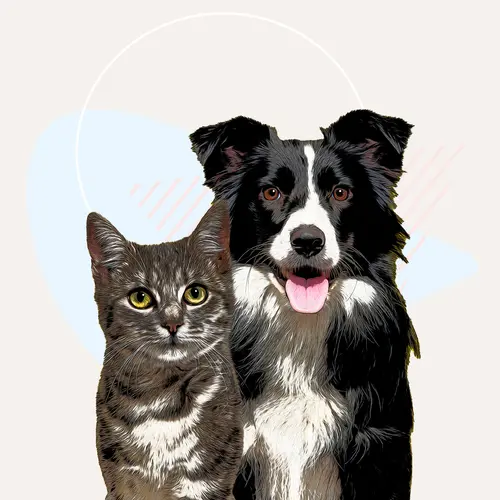Moluccan cockatoos are highly affectionate birds that build a deep bond with their owners as they love socializing and interacting with humans. These qualities make them a great choice as a pet, especially if you live alone and plan to raise the bird yourself. They crave attention and can sometimes become clingy, which is why they thrive when paired with a dedicated owner.
Moluccan cockatoos are remarkably attractive birds, and their beauty is matched by their lively and funny personality. This article looks at some of the common traits of the Moluccan cockatoo and how to care for them.
What Is a Moluccan Cockatoo?
Moluccan cockatoos (Cacatua moluccensis), also called salmon-crested cockatoos, are large white birds with a tuft of feathers on the top of their head. They belong to the same family (Psittacid) as other birds, such as parrots, parakeets, and macaws. They’re named so due to the salmon shade of their crest feathers. Moluccan cockatoos are one of the 21 species of cockatoos native to Indonesia. They are a common sight in the rainforests of the Moluccas, an archipelago in eastern Indonesia.
They’re an endangered species, and it’s illegal to capture them or bring them in from the wild in the US.
Moluccan Cockatoo Characteristics
The Moluccan cockatoo size is the largest among all white cockatoos. They usually grow up to 20 inches (51 centimeters) in height and weigh about two pounds (0.9 kilograms), with females generally being larger than males. Their average wingspan is around 2 feet. The Moluccan cockatoo lifespan is similar to humans, with many birds living up to 65 years or more.
Moluccan cockatoo feathers are mostly white, while some may have a pink or peach shade. But the crest — their defining feature — is salmon. Males have a black beak, while females have a gray-black beak. Moluccan cockatoos raise salmon-colored feathers on their crest when they get excited or feel threatened.
These birds don’t have oil glands and instead release small particles that preserve their feathers and keep them clean. All birds belonging to the cockatoo family have zygodactyl feet (two toes face forward, and two toes face backward) and can use their legs the way humans use their hands. This makes them excellent climbers, a necessary trait to climb around the branches of trees and forage for fruits and nuts. They can hold food with one leg and balance on the other.
Reproduction
In the wild, Moluccan cockatoos live in flocks and separate during the mating season. Moluccan cockatoos reach sexual maturity at the age of five or six. Female cockatoos lay two to six eggs in a clutch and incubate them for 30 days. An unusual feature of Moluccan cockatoos is that both parents participate in incubating the eggs. They are monogamous birds and typically have only one partner for life. They’re known to become depressed when they lose their partner.
Moluccan Cockatoo Personality
Moluccan cockatoos are profoundly intelligent and emotional creatures that crave human attention and interaction. Don’t be surprised if you find your pet cockatoo coming over to you in the morning looking for physical contact, as they have high physical and emotional expectations and can become needy. If owners are unable to meet their physical and emotional expectations, it can cause them stress, leading to self-mutilation, such as plucking their feathers, and constantly screaming.
Other ways the birds act out include dumping their dishes on purpose and destroying perches and other toys in their cage. Taming a Moluccan cockatoo becomes easier if you start early, but it also depends on the specific bird’s nature. But most cockatoos have a natural tendency for close physical contact with their owners. This is one of the primary reasons they make excellent pets. But it can lead to unreasonable demands from some birds, which may put a strain on your other responsibilities.
Moluccan cockatoos may react to sudden changes in your appearance, such as wearing glasses or changing your hairstyle or color. Cockatoos are known to throw a fit of rage when they encounter such situations. The color yellow agitates them considerably more than other colors. Some aviculturists believe this to be an inherited trait that evolved over generations.
A vital aspect of Moluccan cockatoos is that they’re extremely noisy pets. They love making noise, whether to communicate with other birds or just for fun.
Moluccan Cockatoo Care
As Moluccan cockatoos are large, they need larger than normal cages. You’ll need to buy a formidable cage, as these birds have strong beaks that could break thinner-gauge metals. Look for a cage at least 36 inches (91 centimeters) wide, 36 inches deep, and 48 inches (122 centimeters) tall, with bars no more than one inch (2.5 centimeters) apart. Keep the cage locked using an additional padlock, as they may break open the cage door. You can keep a few toys or wooden pieces inside the cage for the birds to chew.
A typical Moluccan cockatoo diet should include fats and proteins. You can feed them diced fresh fruits (apples, oranges, bananas, and papayas), dry seeds, nuts, and beans. Give the birds enough fresh water throughout the day.
Moluccan Cockatoo Facts
- Many cockatoos favor one foot over another (called “footedness”), similar to humans with a stronger hand. Most cockatoos prefer their left foot over their right.
- The name “cockatoo” is derived from the Malay language (commonly spoken in Brunei, Indonesia, and Malaysia, among other countries) and means “vise” or “grip.” It refers to their remarkably powerful beaks.
- Moluccan cockatoos can mimic many animals and people, which can be extremely amusing.
- They’re known to hold their food in one foot and break it using their beaks.
- Moluccan cockatoos are not popular birds in coconut plantations, as they attack young coconuts, chew through the tough outer layer, and reach the soft inner pulp, which they feed on.

